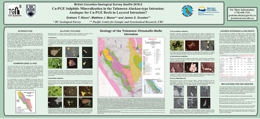| Publication Summary
|
| Issue ID: | GF2018-02 |
| Title: | Cu-PGE sulphide mineralization in the Tulameen Alaskan-type intrusion: Analogue for Cu-PGE reefs in layered intrusions? |
| Author(s): | Nixon, G.T., Manor, M.J., and Scoates, J.S. |
| Series Name: | Geofile |
| Publication Year: | 2018 |
| NTS Map Sheet(s): | 092H/07, 10 |
| Place Keyword(s): | British Columbia, Tulameen |
| Lat/Long (NSWE): | 49.7, 49.3, -121, -120.6 |
| Theme Keyword(s): | platinum group elements, platinum-group minerals, ultramafic intrusion, Alaskan-type, Tulameen intrusion |
| Download(s): | |
Abstract:  | GeoFile 2018-02 is a poster presented at the annual Mineral Exploration Roundup Conference in 2018. The Tulameen Alaskan-type intrusion (Late Triassic) belongs to a global class of ultramafic-mafic bodies emplaced in convergent margin or supra-subduction zone environments. This class of intrusions is gaining prominence as an exploration target for magmatic Ni-Cu platinum group element (PGE) mineralization. The subclass of Alaskan-type intrusions is well known for economic concentrations of Pt in placer deposits derived from chromitites in the dunite core. However, Ni-depleted Cu mineralization spatially associated with such intrusions has not been adequately investigated. Here we present preliminary petrographic, mineralogical and geochemical data pertinent to the development of a new mineral deposit model for orthomagmatic Cu-PGE(-Au-Ag) sulphide mineralization in Alaskan-type intrusions in convergent margin settings. We focus on a well-exposed zone of chalcopyrite-bornite mineralization, the Champion Zone, containing low modal proportions of magmatic sulphides and highly anomalous PGE abundances. The nature of the mineralization resembles aspects of stratiform Cu-PGE reefs in layered intrusions which host most of the world’s Ni and PGE resources. |





